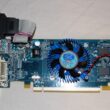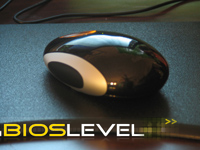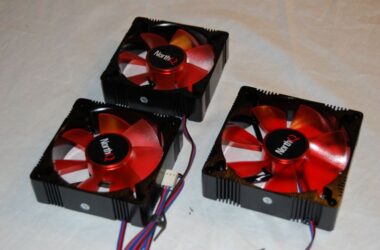Introduction
Home Theater PCs have come a long way since their inception years ago, and it should come as no surprise that HTPC cases have evolved as well. Much like the desktop computer, users are not longer stuck with the boring gray boxes of the past, nor are they stuck with cases that are meant for desktop use. Many companies have chosen to design HTPC cases that mimic or fit the stylings of modern home theater components such as DVD players and surround sound systems.
nMedia’s HTPC 1000-series cases is a shining example of this design philosophy. The folks at nMedia were kind enough to send us an evaluation unit to try out. The 1000-series comes in either black or silver, and features a hidden optical bay, card readers, optional LCD output, and much more.
Features
- Support ATX power supply & Micro ATX motherboard
- 4 X 3.5″ internal bays for media data
- Easy upfront access digital connection interfaces (behind door)
- e-SATA; HD Audio; SDHC 2.0 Card Reader; USB 2.0; IEEE 1394
- Support full height & length PCI cards
- Stylish aluminum panel
- Compact size and feel
- Optional upgrade on 20×2 programmable MCE LCD module
- Innovated chassis architecture design makes your installation easy
- Quiet as always.
Specifications
| Model | HTPC 1000B & HTPC 1000S |
| Color | Black and Silver |
| Dimension | Case: 17″(W) x 5.4″(H w/ feet) x 16.3″(D w/ panel) Metal Chassis: 17″(W) x 5.1″(H) x 15.4″ (D) |
| Material | Aluminum Panel & Steel |
| Motherboard | Support Micro-ATX |
| Power Supply | Support ATX PSU (not included) |
| Drive Bays | External 5.25? Bay x 1 Internal 3.5? Bay x 4 |
| Expansions | 4 Slots / Full Size |
| Cooling | 60mm Silent Case Fan x 2 90mm Case Fan x 1 |
| Front Connection | eSATA x 1 for your external hard drive High Definition Audio x 2 (AC 97 compliance) All in one Card Reader (SDHC 2.0 compliance – high capacity & speed) IEEE 1394 x 1 | USB 2.0 x 3 |
| LCD Display | (Optional, not included) 20X2 Programmable LCD display module with Internal USB connector, support Windows, Media Center Edition 2005, Vista and Vista Media Center Edition operating system. |
Packaging and Appearance
The 1000 was shipped in a brown cardboard box, with the case itself protected by two pieces of sturdy Styrofoam and a soft bag to protect it from scratches.
The front of the 1000 is made from beautiful brushed aluminum. Two vandal switches are accessible for power and reset functionality. The optical drive sits behind the aluminum bezel, adding to the case’s beauty. Below the optical bay is the space for the optional LCD screen.
The lower portion of the case’s front lowers to reveal a slew of ports and a card reader. The case really does shine with this added functionality and expandability, but could possibly have been done better without hiding the ports behind a door.
The sides and top of the case are merely utilized for ventilation.
The rear of the case shows support for a micro-ATX motherboard and a full-size powersupply. Also of note are the two fans that sit above the motherboard shield, as well as the large thumbscrews for removing the top panel.
With the top panel removed, the inside is exposed. The interior is rather plain, but it can be seen that the two rear fans require four-pin molex connectors for power. Most modern motherboards, micro-ATX or otherwise, feature more than two sets of fan connectors. Using these connectors would not only allow the motherboard to adjust the fan speed, but it would also eliminate the need to run an extra power cable to these fans from the power supply.
On the front side of the interior, these is a single drive cage piece that holds all the drives for the system. By removing a screw or two, the cage pulls out from the case to simplify drive installation. The hard drive cages feature rubber grommets to kill noise.
A single fan, larger than the rear fans, resides on one of the side panel vents, and again requires a four-pin molex connection for power.
Installation
Installation wasn’t difficult in the least, but there were a few tricks to be learned.
Examining the drive cage, which holds both the optical and hard drives, I found out that by removing two screws in the top of the frame, the cage lifted out, simplifying the process of installing the drives.
Next, I installed the motherboard, a mini-ITX board in this case. The board fit fine, as did the shield on the rear.
I installed my selected drives in the drive cage and re-inserted the drive cage. This took a few tries so I could have the optical drive lined up properly with the case’s door and eject button. Then I began work on cables.
The last step was to install the power supply. I was at first worried about the space that a power supply may take up, but everything fit fine in the end.
Final Thoughts and Conclusion
The case looks beautiful. I wish BIOSLEVEL had received an LCD module with this case for additional testing, but the case is great as it is. The exterior looks great with stereo equipment, and installation was mostly a snap. The interior is loaded up with silencing technologies such as quiet fans and grommets for the the various drives. The case definitely helps keep the machine inside running quiet.
I can’t think of many ways on how to improve this case, as it fits what it’s meant to do and looks beautiful doing it. I’m not a total fan or the door that hides all the front connections. I think at the very least it should be partitioned so you only lower parts you’re currently using. Beyond that, the case has made a fantastic addition to my media center.
nMedia specializes in a lot of HTPC equipment, and the 1000-series HTPC is a perfect case to build a HTPC in using many of their products.
Pros
- Plenty of expansion slots
- Great pricing point
- Lots of space
- Plentiful front connections
- Optional LCD module
Cons
- Limited drive space
- Optional LCD module
- Non-standard size rear cooling




























